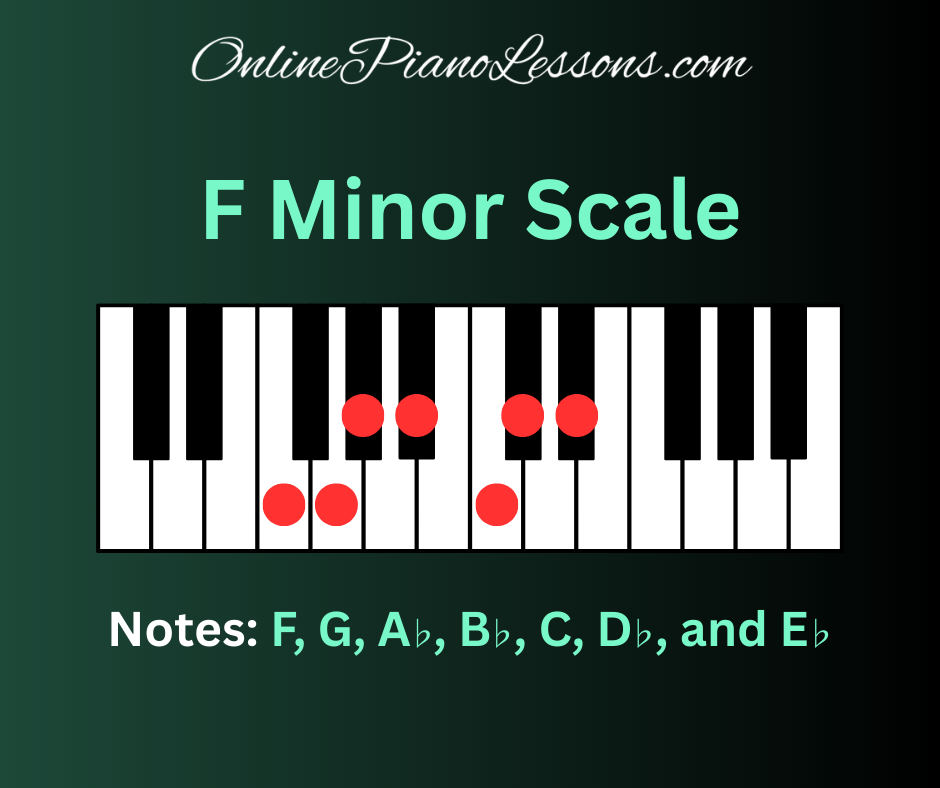
If you want intensity, mystery, and a sound palette that’s both brooding and beautiful, the f minor scale is a go-to. From thunderous classical sonatas to intimate piano nocturnes, the f minor scale surfaces wherever composers want emotional gravity. This guide covers everything: the note spellings for all common forms, key signature and relatives, fingerings for piano, the harmony the f minor scale creates, musical uses, practice routines, and a short FAQ to clear up the usual questions. By the end you’ll know exactly when and how to use the f minor scale in practice and playing.
What is the f minor scale?
The f minor scale is a minor-key collection with F as the tonic. In its natural form (the one you’ll see on the staff most often), the f minor scale has a dark, somber color thanks to its third degree (A♭). Like every minor scale, it comes in three common flavors:
- F natural minor — the baseline version you use for key signatures and basic harmony.
- F harmonic minor — raises the 7th degree to create a stronger leading tone into F.
- F melodic minor — raises the 6th and 7th ascending for smoother melodic motion; often reverts to the natural form when descending (classical usage).
Each variation of the f minor scale has its own practical uses: natural for modal or static minor sound, harmonic for strong cadences, and melodic for lyrical, ascending lines.
Key signature and relatives
- Key signature: 4 flats — B♭, E♭, A♭, D♭.
- Relative major: A♭ major (same key signature).
- Parallel major: F major (one flat; different tonal character).
Because the f minor scale shares four flats with A♭ major, you’ll often see pieces move fluidly between those keys for contrast.
Notes: all three common forms of the f minor scale
F Natural Minor (Aeolian) — the “default” f minor scale:
F – G – A♭ – B♭ – C – D♭ – E♭ – F
F Harmonic Minor — raise the 7th (E♭ → E natural):
F – G – A♭ – B♭ – C – D♭ – E – F
F Melodic Minor (classical) — raise 6th and 7th ascending (D♭ → D, E♭ → E); revert descending:
- Ascending: F – G – A♭ – B♭ – C – D – E – F
- Descending (classical): F – E♭ – D♭ – C – B♭ – A♭ – G – F
In jazz practice, the ascending melodic minor is often used in both directions. Each of these versions is considered part of the toolbox when you work with the f minor scale.
How the f minor scale builds chords (harmony)
Start with the natural form: build triads on each scale degree.
Diatonic triads in F natural minor:
- i — F minor (F–A♭–C)
- ii° — G diminished (G–B♭–D♭)
- III — A♭ major (A♭–C–E♭)
- iv — B♭ minor (B♭–D♭–F)
- v — C minor (C–E♭–G)
- VI — D♭ major (D♭–F–A♭)
- VII — E♭ major (E♭–G–B♭)
When you switch to f harmonic minor (E♮ instead of E♭), the V chord becomes C major (C–E–G), which creates a powerful dominant that resolves naturally to F. That is why classical cadences often use the harmonic form of the f minor scale. The melodic form (with D and E natural ascending) smooths melodic lines and offers additional color for improvisation and jazz harmony.
Fingerings for piano — practical, reliable patterns
Good fingering makes the f minor scale feel natural rather than awkward. Below are standard two-octave suggestions that work for most players.
Right hand (RH) — natural & harmonic F minor (one octave pattern repeats):
- Ascend: 1 – 2 – 3 – 1 – 2 – 3 – 4 – 5 (F G A♭ B♭ C D♭ E♭ F)
- Descend: reverse slowly and evenly.
Left hand (LH) — natural & harmonic F minor:
- Ascend: 5 – 4 – 3 – 2 – 1 – 3 – 2 – 1
- Descend: reverse the pattern.
For f melodic minor ascending, the same finger patterns apply — the pitches change (D and E natural), but the thumb crossings and general flow remain the same. Practice hands separately first, paying attention to the D♭/D and E♭/E changes so the accidentals don’t trip you up.
Practice plan: learn the f minor scale in 30 days
Use this progressive routine to make the f minor scale comfortable and musical.
Week 1 — basics
- Days 1–3: One-octave F natural minor, hands separate, slow metronome (♩=60). Say note names aloud.
- Days 4–7: Two-octave F natural minor hands together, straight rhythms and dotted rhythms.
Week 2 — variations and technique
- Days 8–10: One-octave F harmonic minor hands together; focus on the raised 7th (E natural).
- Days 11–14: Two-octave harmonic minor, add accents on beats 1 & 3.
Week 3 — melodic motion & musicality
- Days 15–17: F melodic minor ascending/descending—practice ascending form until comfortable.
- Days 18–21: Contrary motion: RH ascends while LH descends.
Week 4 — application and improvisation
- Days 22–24: Arpeggios and triad inversions of F minor, D♭ major, A♭ major, E♭ major.
- Days 25–30: Short improvisations over a simple vamp (Fm – D♭ – A♭ – E♭), mixing natural, harmonic, and melodic forms.
This plan makes the f minor scale both technical and musical — not just a mechanical drill.
Musical uses: where the f minor scale shines
- Expressive classical pieces: The f minor scale is often chosen when composers want tragic or stormy moods. Beethoven’s Piano Sonata No. 23, the “Appassionata,” is a famous F-minor work that uses the scale’s dramatic potential.
- Lyrical nocturnes and miniatures: Chopin and other romantic composers explored subtle, melancholic flavors in F minor pieces.
- Modern songwriting: The f minor scale works well for introspective songs and moody chord progressions on piano and synths.
- Jazz & improvisation: Use melodic minor ideas (raised 6th & 7th) for lines over ii–V–i resolutions or to evoke a more “contemporary” minor sound.
Because the f minor scale contains useful chromatic options (E natural or D natural when needed), it’s flexible for harmonic color and melodic expression.
Common problems and fixes
- Problem: thumb bump at the cross-under.
Fix: slow down the passage, practice the thumb-under motion in isolation, and keep the thumb relaxed and close to the keys. - Problem: accidental mix-ups (D♭ vs D natural, E♭ vs E natural).
Fix: call out the note names while playing slowly, and practice the harmonic and melodic versions separately until the raised notes feel intentional. - Problem: tension when speeding up.
Fix: drop the tempo by 15–20 bpm and focus on relaxed wrists and even finger weights; only increase tempo once tone and relaxation are stable. - Problem: sound is flat/unnatural in expression.
Fix: add dynamics (pp to ff), phrase the scale as a musical line, and link scale practice to short melodies in F minor to make it musical.
Quick theory cheat-sheet
- Key signature: 4 flats (B♭, E♭, A♭, D♭) — same as A♭ major.
- Relative major: A♭ major.
- Primary cadence trick: Use f harmonic minor (raise 7th to E) to get a strong V → i (C → F) resolution.
- Modal cousin: F Dorian (if you want a brighter minor sound) is F G A♭ B♭ C D E♭.
Famous works (listen and learn)
-
Beethoven — Piano Sonata No. 23 “Appassionata” (F minor) — an intense example of F-minor drama and virtuosity.
-
Chopin — Nocturne in F minor, Op. 55 No. 1 — a lyrical piece that explores the expressive side of the f minor scale.
Listening to repertoire in F minor while following the score is one of the fastest ways to internalize how composers use natural, harmonic, and melodic versions of the f minor scale.
Final thoughts
The f minor scale is a dramatic and versatile tool. Whether you’re drilling scales for technique, composing a haunting melody, or improvising over a minor vamp, understanding the natural, harmonic, and melodic forms will expand your musical options. Make the f minor scale both a technical habit and a musical language: practice it slowly, listen to pieces written in F minor, and apply it in real musical contexts. Few scales give you such immediate expressive payoff — enjoy the process, and let the f minor scale color your playing.
FAQ — f minor scale
Q1: What notes are in the f minor scale?
A: The F natural minor scale is F, G, A♭, B♭, C, D♭, E♭, F. Harmonic minor raises E♭ to E natural. Melodic minor raises D♭→D and E♭→E ascending (often reverting descending).
Q2: What is the key signature of the f minor scale?
A: Four flats: B♭, E♭, A♭, and D♭. That’s the same signature as A♭ major, the relative major of the f minor scale.
Q3: Which F minor form should I learn first?
A: Start with the F natural minor to lock in the key signature and basic triads. Add harmonic minor for cadences and melodic minor for smoother ascending lines.
Q4: How can I use the f minor scale when improvising?
A: Improvise over an Fm vamp using chord tones (F, A♭, C) as anchors. Use harmonic F minor (E natural) over a dominant C or C7 chord to create strong resolutions. Mix melodic minor shapes for more modern-sounding lines.
Q5: How long will it take to master the f minor scale?
A: With focused daily practice (15–30 minutes) and the progressive 30-day plan above, you’ll have reliable hands-on familiarity in a few weeks. Mastery (speed + musicality) takes months of varied practice and application.





 Hi, I'm Thomas, Pianist Composer,
Hi, I'm Thomas, Pianist Composer,  I love playing piano, creating new melodies and songs, and further developing my online piano course and making updates/additions to my site OnlinePianoLessons.com!
I love playing piano, creating new melodies and songs, and further developing my online piano course and making updates/additions to my site OnlinePianoLessons.com!  Now that is what I call fun!
Now that is what I call fun!





